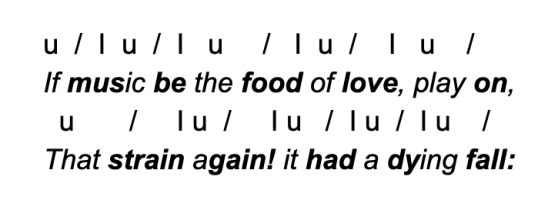

Iambic pentameter must always contain only five feet, and the second foot is almost always an iamb.

There are some conventions to these variations, however. The divisions between feet are marked with a |, and the caesura (a pause) with a double vertical bar ||.Īlthough strictly speaking, iambic pentameter refers to five iambs in a row (as above), in practice, poets vary their iambic pentameter a great deal, while maintaining the iamb as the most common foot. The scansion of this can be notated as follows: The following line from John Keats' Ode to Autumn is a straightforward example: To swell the gourd, and plump the hazel shells In this notation a line of iambic pentameter would look like this: It is possible to notate this with a ' ˘' ( breve) mark representing an unstressed syllable and a ' /' ( slash or ictus) mark representing a stressed syllable. When I do count the clock that tells the time The tick-TOCK rhythm of iambic pentameter can be heard in the opening line of Shakespeare's Sonnet 12: The da-DUM of a human heartbeat is the most common example of this rhythm.Ī line of iambic pentameter is five iambic feet in a row: William Shakespeare used iambic pentameter in his plays and sonnets.Īn iambic foot is an unstressed syllable followed by a stressed syllable. Iambic pentameter is the most common meter in English poetry it is used in many of the major English poetic forms, including blank verse, the heroic couplet, and some of the traditional rhymed stanza forms. Iambic rhythms come relatively naturally in English. Iambic pentameter is a line made up of five such pairs of short/long, or unstressed/stressed, syllables. The English word " trapeze" is an example of an iambic pair of syllables, since the word is made up of two syllables ("tra-peze") and is pronounced with the stress on the second syllable ("tra- PEZE", rather than " TRA-peze"). When a pair of syllables is arranged as a short followed by a long, or an unstressed followed by a stressed, pattern, that foot is said to be "iambic". An English unstressed syllable is equivalent to a classical short syllable, while an English stressed syllable is equivalent to a classical long syllable. In English, the rhythm is created through the use of stress, alternating between unstressed and stressed syllables.

In Ancient Greek and Latin, the rhythm is created through the alternation of short and long syllables. Different languages express rhythm in different ways. They were adopted to describe the equivalent meters in English accentual-syllabic verse. These terms originally applied to the quantitative meter of classical poetry. The word "pentameter" indicates that a line has five of these feet. The word " iambic" describes the type of foot that is used (in English, an unstressed syllable followed by a stressed syllable). That rhythm is measured in small groups of syllables these small groups of syllables are called " feet". The term describes the particular rhythm that the words establish in that line. Iambic pentameter is a commonly used metrical line in traditional verse and verse drama.


 0 kommentar(er)
0 kommentar(er)
